Mass of dark matter revealed by precise measurements of Milky Way galaxy

A research team, led by Associate Professor Mareki Honma from the National Astronomical Observatory of Japan (NAOJ), has succeeded in precisely determining the astronomical yardstick for the Galaxy based upon the precise distance measurements with VERA from NAOJ and other advanced radio telescopes. The new findings are that the distance from the sun to the Galactic center is 26,100 light-years, and that the Galactic rotation velocity in the solar system is 240km/s.
The Galactic rotation velocity from this research is higher than that of previously known (220km/s). This results in the conclusion that the mass of the Galaxy, especially that of dark matter, is about 20% larger than what has been previously considered.
What is our Milky Way Galaxy like? How big? How heavy? What shape? We know now that the Galaxy is a spiral galaxy, but precise information including its size, shape, and rotation velocity, has not been made clear yet.
The biggest reason is that we cannot see the Galaxy from the outside since we stay inside the Galaxy. In order to see the whole shape of the Galaxy from the inside, it is necessary to precisely measure the distance of each one of the many Galactic objects, and make a "Galactic map" with an overhead view.
In that case, trigonometric parallax, or annual parallax, is utilized to measure the distance to an object without any "what if?" assumptions. The trigonometric parallax is the difference in position of an object, which is generated when the earth orbits around the sun (see Figure 1). However, the difference is extremely small; even that of Alpha Centauri, the nearest star from the Sun, is one arcsecond or less. Therefore, we could not measure any areas beyond 1,000 light-years away from the solar system by using the annual parallax because of the measurable limit of the parallax. The distance of 1,000 light-years is far smaller than the distance from the Sun to the Galactic center (approximately 26,100 light-years, as mentioned later). This means that measuring the area of the Galaxy has been a frontier left for modern astronomy.
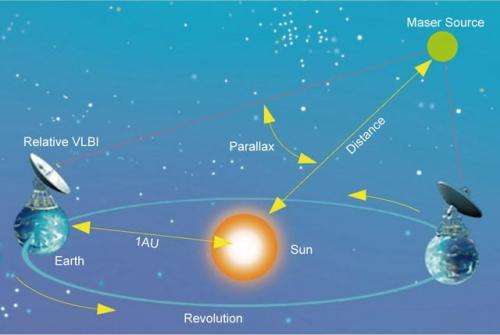
VERA (VLBI Exploration of Radio Astrometry), with which we have continued our research, is a group of radio interferometers; 20-meter radio telescopes are installed in Oshu City in Iwate Prefecture, Satsumasendai City in Kagoshima Prefecture, Ogasawara Village in Tokyo, and Ishigaki City in Okinawa Prefecture (see Figure 2). This is a project to precisely measure distances to objects with the technology of Very Long Baseline Interferometry (VLBI), and to identify the 3D structure of the Galaxy. Mizusawa VLBI Observatory of NAOJ is operating VERA in cooperation with Kagoshima University and other organizations. The construction of VERA was finished in 2002, and astronomical observations to measure distances to stars have been regularly conducted since 2007.
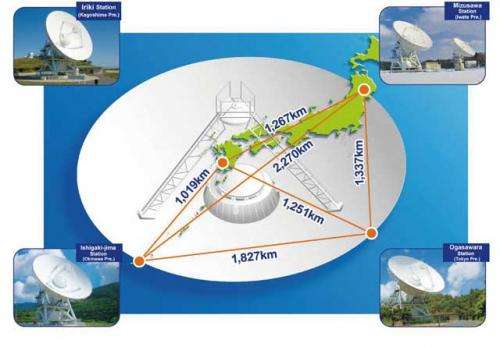
VERA has completed observations of more than 100 radio objects (maser sources) in the Galaxy, and so far we have reported on the precise distances and motions of approximately 30 of those objects. This time, we determined the Galactic yardstick based upon the precise distance measurements with the observation results of 52 objects in total (Figures 3 and 4): 19 star-forming regions (newly-born stars) observed at VERA, and other objects observed by the Very Long Baseline Array (VLBA) of US equipment, and by the European VLBI Network (EVN). In this report, the latest measurement results of VERA were added, making it the world's first analysis of Galactic structure using more than 50 objects.

This research successfully managed to determine the Galactic yardsticks precisely: the R0 value of the distance to the Galactic center from the solar system, and the Θ0 value of the Galactic rotation velocity in the solar system. The distance to the Galactic center is R0=8.0 +/- 0.5 kpc (approximately 26,100 light-years +/-1,600 light-years), and the Galactic rotation velocity in the solar system is Θ0=240 +/- 14 km/s. (See Figure 5)
-
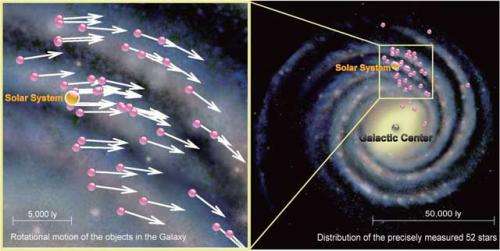
Figure 4: Image of the Galaxy image seen from above, and the distribution of the precisely measured 52 stars (marked in red). -
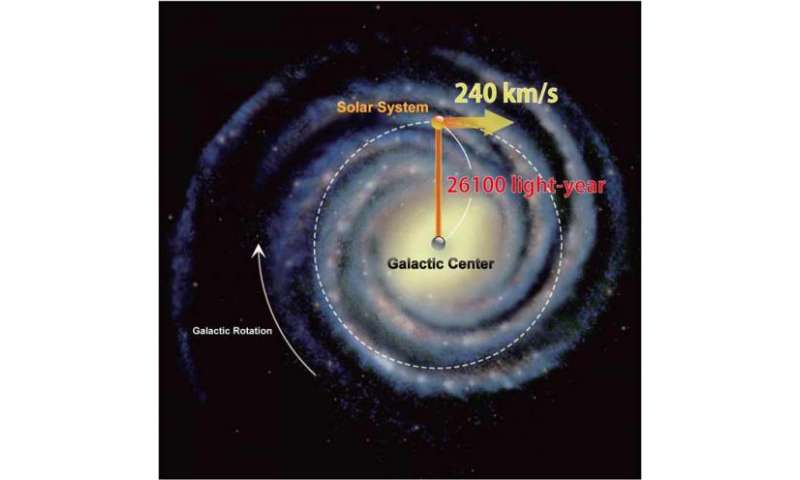
Figure 5: An Artist's rendering of the face-on view of the Galaxy. The yardsticks of the Milky Way Galaxy determined from this analysis. The following two values were precisely measured: the distance to the Galactic center from the solar system is 26,100 light-years; the Galactic rotation velocity in the solar system is 240 km/s. From the data on distance and velocity, it has been learned that the solar system takes approximately 200 million years to revolve around the inner the Galaxy once.
The value of Galactic rotation velocity from this research is larger than V0=220km/s, the one endorsed by the International Astronomical Union (IAU) since 1985. This finding now forces them to change the rotation speed and mass distribution of the Galaxy, as mentioned later. On the other hand, the distance to the galactic center is almost equal, within an 8.5 kpc (approximately 27,700 light-years) margin of error, as that endorsed by the IAU since 1985. However, one of the most important points is that this measurement was directly and more precisely done with the triangulation method and is more precise.
In addition to these yardsticks, it is also confirmed that the Galactic rotation velocity is almost constant between the distances of 10,000 and 50,000 light-years from the Galactic center (see Figure 6).
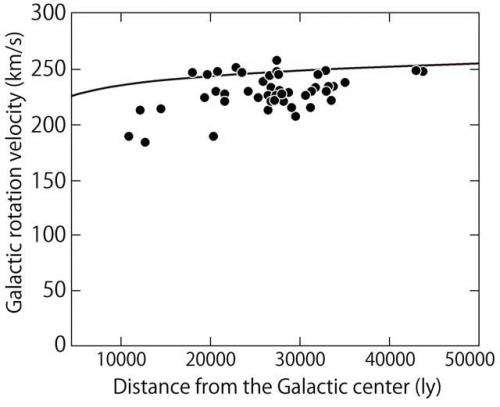
In general, galactic rotation velocity is determined by the balance with galactic gravity. Therefore measuring galactic rotation is equal to measuring Galaxy's mass. When the Milky Way's mass within the solar system is measured with the latest Galactic rotation velocity from this research (Θ0=240 km/s), the amount should increase by no less than approximately 20%. It means that the total amount of dark matter in this area is larger than projected up until now.
The current main theory of dark matter is that it consists of elementary particles. At the moment, some experimental particle physicists have been carrying out dark-matter detection experiments to directly detect dark matter. Our research findings also impact any experiments with for dark matter search.
The findings of this research emphasize again that the precise measurements of the Milky Way Galaxy promoted by VERA are effective to determine the structure of the Galaxy. This is also a milestone achievement as the year 2012 is the 10th anniversary of VERA's completion, and also the turning point of the fifth year from its initial results. In the future, we will continue observations with VERA to increase the number of objects measured to several hundred in about 10 years. We expect to determine the basic structure of the Milky Way Galaxy more precisely.
In addition to VERA, other observations are also available with VLBA and EVN, and with the GAIA satellite expected to launch in 2013. In light of this, our understanding of the Galaxy should drastically improve in the next 10 years.
Provided by National Astronomical Observatory of Japan





















